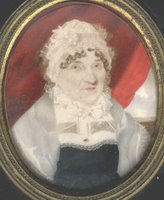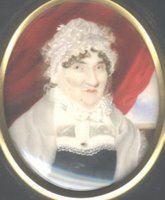This collection focuses on original miniatures and, apart from some illustrative examples, tends to exclude those produced as decorative items. Nevertheless, some copies by famous artists such as Henry Pierce Bone, have become important items over time. Other decorative items are very collectible in their own right.
Original miniatures, where someone sat for the portrait and both the sitter and the artist are known, are preferred for this collection. They probably represent only one or two in every hundred miniatures offered for sale in marketplaces such as on-line auctions.
Most original miniatures, being say, one third of all miniatures on offer for sale at public or on-line auctions, are either unsigned or the sitter is unknown. However, the proportion identified will be higher at the dedicated portrait miniature auctions held by a few major auction houses and by specialist dealers in miniatures .
In the experience of this collector, the other two-thirds of miniatures seen for sale at on-line auctions or by bric-a-brac type antique dealers, are decorative copies. Copies of miniatures fall into several main categories.
Copies by the Original Artist

 These are where the original artist made several identical copies of a miniature, for example for different members of a family.
These are where the original artist made several identical copies of a miniature, for example for different members of a family.It is unusual to find these examples, but they do exist and shown here are two portraits by Charles Foot Tayler, both signed "C F Tayler 1820". One of these was acquired from California, USA and the other from Kent, UK. Thus it was nice to reunite them. These duplicates may have been painted at the same time or perhaps one several years later.
Even today there are artists painting modern miniature portraits for clients, although they are often much more expensive than the majority of antique miniatures.
Official Copies by Important Artists
Often copies of known portraits were requested from listed artists. Sometimes these were noted as copies, but generally without any intention to deceive.
 Even in this category of copies, there are some very expensive miniatures. In the 18C and 19C some very famous artists, such as Henry Bone and his son Henry Pierce Bone, painted very fine miniature copies on enamel of large portraits and these now sell for very high prices.
Even in this category of copies, there are some very expensive miniatures. In the 18C and 19C some very famous artists, such as Henry Bone and his son Henry Pierce Bone, painted very fine miniature copies on enamel of large portraits and these now sell for very high prices.The example shown here is a miniature in enamel of the poet Lord Byron by Henry Pierce Bone. It is a miniature copy of a famous large oil of Byron.
Also from the time of the earliest miniatures, it was often practice for royalty to have multiple copies of miniatures painted for presentation to foreign ambassadors.
Artists such as Anton Freidrich Konig and Juda Pinhas made many miniature copies of large oil portraits of Frederick the Great by other artists for this purpose.
Elsewhere in this collection there is just such a miniature by Pinhas, of Frederick the Great. See European Miniature Portraits - 2: Pinhas, Jude Low - portrait of ...


Miniature copies like these can be found. The one shown here is expertly painted and has a faint signature of "E Miles", who was active in St Petersburg, Russia from 1797-1806 where he was Court Painter to the Tsar.
The sitter is Grand Princess Alexandra Pavlovna (1783-1801), who was daughter of Tzar Paul I (1754-1801) wearing the red sash of the Grand Cross of the Order of St. Catherine, which was conferred to every Russian Grand Duchess upon her christening (or upon her marriage into the Romanov family).
 The original painted in 1797 and a shown here, is in the State Russian Museum of Fine Arts in Moscow and is attributed to Miles. It looks identical to the version in this collection, apart from the style of the frame.
The original painted in 1797 and a shown here, is in the State Russian Museum of Fine Arts in Moscow and is attributed to Miles. It looks identical to the version in this collection, apart from the style of the frame.The frame of the one in this collection is tortoiseshell expensively inlaid with gold, mother-of-pearl, and abalone. Thus it is possible that it is an official copy made to give to a member of the Court, as the combined miniature and frame would have been very expensive.
The doubt about this being by Miles, is that he did not normally sign his work and the frame style here seems to be somewhat later than the date of the original. However, it is still by a very good artist and is very similar to Miles' work. So much time and skill was required to make a copy of this standard, that it was usually not worth the effort of a faker to do so.
 Fakes and Decorative Copies
Fakes and Decorative CopiesBy far the most common, are the decorative copies often mass produced in the late 19C and early 20C.
Studios were set up especially in France and Germany and hundreds, if not thousands, of copies of a single famous miniature, or miniatures based on 18C and 19C engravings, would emerge from a variety of these studios which were more like factories. The quality of these copies varies enormously.
The best examples such as the one here of Madame Pompadour were very well painted and deserve to be collected in their own right.
They were generally on ivory, but cheaper versions were simply printed on celluloid, sometimes with limited over-painting of the highlights, often in opaque white. Close examination of these readily shows their poor quality.
They often had a fake signature of a famous artist added. These are usually easy to spot due to the lack of quality which does not match that of the named artist. Separately, there are copies of better known miniatures, which appear to have been painted by students learning to paint.
 Decorative miniatures may have the purported signature of the original artist, be unsigned, or have a deliberately wrongly spelled name of a famous artist of an earlier period, such as Cobway for Cosway. Names like Stieler, Nattier, Cosway, Smart, and Isabey or variations upon their names are commonly found.
Decorative miniatures may have the purported signature of the original artist, be unsigned, or have a deliberately wrongly spelled name of a famous artist of an earlier period, such as Cobway for Cosway. Names like Stieler, Nattier, Cosway, Smart, and Isabey or variations upon their names are commonly found.Often they are copied from old engravings and so the colours may be different to the originals and the images can be reversed.
 Many have frames that when looked at, can be seen to have been made of old piano keys pieced together. Some have very ornate pierced frames.
Many have frames that when looked at, can be seen to have been made of old piano keys pieced together. Some have very ornate pierced frames.Others have pages of old books covering the reverse to give a false impression of great age.
Some decorative miniatures were not traditional portraits and shown here are two charming decorative miniatures of cupids.
One shows the cupids forging an arrow in a fire and the second shows that the arrow has successfully hit its target, a heart. This symbolises a common purpose of a miniature portrait, as a romantic gift to a lover.
For more examples of Fakes and Decorative miniatures, including a large selection of the various types of frames used for early 20C decorative miniatures, see View
Modern Decorative Miniatures

 Decorative miniatures are still being painted and some of them are of a very high standard. Shown here are four Russian miniatures painted since 2000. They are of Tsar Nicholas II and his wife Alexandra, together with two of his children, Grand Duchess Tatania amd Grand Duchess Anastasia.
Decorative miniatures are still being painted and some of them are of a very high standard. Shown here are four Russian miniatures painted since 2000. They are of Tsar Nicholas II and his wife Alexandra, together with two of his children, Grand Duchess Tatania amd Grand Duchess Anastasia.This type of miniature is called Fedoskino or Palekh miniatures, after the Russian villages where many are still painted using lacquer on a papier-mache base. For more about them see Russian lacquer miniature - Fedoskino These can be purchased relatively inexpensively and would make a great basis for a collection for anyone interested in collecting miniature art, but with a tight limit on the amount of money they can spend.

 Miniatures by Fedoskino artists can provide a means of forming an attractive and inexpensive collection, and in doing so provide an insight into the times and events associated with the originals.
Miniatures by Fedoskino artists can provide a means of forming an attractive and inexpensive collection, and in doing so provide an insight into the times and events associated with the originals.
1 comment:
Your blog is lovely. I appreciate all the information and being able to see these lovely works of art! Have a fabulous New Year!
Take Care,
Robin
Post a Comment